Articles
- Page Path
- HOME > J Korean Acad Nurs > Volume 46(4); 2016 > Article
-
Original Article
- Mixed Method Research Investigating Evidence-Based Practice Self-efficacy, Course Needs, Barriers, and Facilitators: From the Academic Faculty and Clinical Nurse Preceptors
- Eui Geum Oh, You Lee Yang, Jae Yong Yoo, Ji Yun Lim, Ji Hyun Sung
-
Journal of Korean Academy of Nursing 2016;46(4):501-513.
DOI: https://doi.org/10.4040/jkan.2016.46.4.501
Published online: August 31, 2016
1College of Nursing, Mo-Im Kim Nursing Research Institute, Yonsei University, Seoul, Korea.
2College of Nursing, Graduate School, Yonsei University, Seoul, Korea.
3Department of Nursing Science, College of Medicine, Chosun University, Gwangju, Korea.
4Department of Nursing, Severance Hospital, Seoul, Korea.
- Address reprint requests to : Sung, Ji Hyun. College of Nursing, Mo-Im Kim Nursing Research Institute,Yonsei University, 50 Yonsei-ro, Seodaemun-gu, Seoul 03722, Korea. Tel: +82-2-2227-7975, Fax: +82-2-392-5440, joyrnsjh@gmail.com
© 2016 Korean Society of Nursing Science
This is an Open Access article distributed under the terms of the Creative Commons Attribution NoDerivs License. (http://creativecommons.org/licenses/by-nd/4.0/) If the original work is properly cited and retained without any modification or reproduction, it can be used and re-distributed in any format and medium.
Abstract
-
Purpose
- The current challenges faced by nurses in providing high quality and evidence-based practice (EBP) supported care require profound changes in nursing education. To understand the changes needed to strengthen EBP education, the researchers examined EBP self-efficacy, course needs, barriers, and facilitators for academic faculty and clinical nurse preceptors to teach EBP in undergraduate nursing curricula.
-
Methods
- For this study, mixed-method approach was used with survey data collected from 73 academic faculty members from 54 universities. Further, 17 clinical nurse preceptors in three academic hospitals provided qualitative data for exploration of barriers and facilitators to teaching EBP. Data analysis used SPSS/WIN 21.0 and content analysis.
-
Results
- Quantitative data showed that although the overall level of self-efficacy among faculty was moderate, the implementation levels were relatively low. Most faculty members agreed with the need to integrate EBP courses into undergraduate nursing curricula. The qualitative data showed that the barriers to teaching EBP were lack of knowledge, skill, and initial investment for teaching EBP; hierarchical, rules-oriented nursing culture; potential learner overloads in processing EBP; limited research dissemination and application. Facilitators were identified as the importance of EBP to the profession of nursing; collaboration in schools and hospitals; and continuing education in teaching/utilizing EBP.
-
Conclusion
- The findings indicate that for successful integration of EBP ni nursing education there is a need for faculty training and integrated EBP courses.
This research was supported by the Basic Science Research Program through the National Research Foundation of Korea (NRF) funded by the Ministry of Science, ICT & Future Planning (2013R1A1A3009060).
The authors declared no conflict of interest.
- 1. Sackett DL, Rosenberg WM, Gray JA, Haynes RB, Richardson WS. Evidence based medicine: What it is and what it isn't. BMJ: British Medical Journal. 1996;312(7023):71–72.ArticlePMC
- 2. Choe MA, Bang KS, Park YH, Kang HJ. Current status and direction for future development of evidence-based nursing in Korea. Perspect Nurs Sci. 2011;8(2):129–138.
- 3. National Evidence-based Healthcare Collaborating Agency. Costing method in health care[Internet]. Seoul, Author. 2013;cited 2015 August 3. Available from: http://neca.re.kr/eng/publication/report_view.jsp?boardNo=EE&seq=6659&q=626f6172644e6f3d4545
- 4. American Association of Colleges of Nursing. The essentials of baccalaureate education for professional nursing practice[Internet]. Washington, DC, Author. 2008;cited 2015 September 9. Available from: http://www.aacn.nche.edu/education-resources/BaccEssentials08.pdf
- 5. Korean Accreditation Board of Nursing Education. Nursing education accreditation standards: Evaluation criteria and indicators [Internet]. Seoul, Author. 2013;cited 2014 January 23. Available from: http://www.kabon.or.kr/eng/index.php
- 6. Hussein AHM, Hussein RG. Nursing educators' knowledge, skills in evidence-based practice and their critical thinking skills: Self report study. J Educ Pract. 2014;5(27):86–94.
- 7. Fineout-Overholt E, Johnston L. Teaching EBP: A challenge for educators in the 21st century. Worldviews Evid Based Nurs. 2005;2(1):37–39. ArticlePubMedPDF
- 8. Heye ML, Stevens KR. Using new resources to teach evidence-based practice. J Nurs Educ. 2009;48(6):334–339. ArticlePubMed
- 9. Llasus L, Angosta AD, Clark M. Graduating baccalaureate students' evidence-based practice knowledge, readiness, and implementation. J Nurs Educ. 2014;53:9 Suppl. S82–S89. ArticlePubMed
- 10. Finotto S, Carpanoni M, Turroni EC, Camellini R, Mecugni D. Teaching evidence-based practice: Developing a curriculum model to foster evidence-based practice in undergraduate student nurses. Nurse Education in Practice. 2013;13(5):459–465. ArticlePubMed
- 11. Burke LE, Schlenk EA, Sereika SM, Cohen SM, Happ MB, Dorman JS. Developing research competence to support evidencebased practice. J Prof Nurs. 2005;21(6):358–363. ArticlePubMed
- 12. Stichler JF, Fields W, Kim SC, Brown CE. Faculty knowledge, attitudes, and perceived barriers to teaching evidence-based nursing. J Prof Nurs. 2011;27(2):92–100. ArticlePubMed
- 13. Allinder RM. An examination of the relationship between teacher efficacy and curriculum-based measurement and student achievement. Rem Spec Educ. 1995;16(4):247–254. ArticlePDF
- 14. Nugent KE, Bradshaw MJ, Kito N. Teacher self-efficacy in new nurse educators. J Prof Nurs. 1999;15(4):229–237. ArticlePubMed
- 15. Ciliska D. Educating for evidence-based practice. J Prof Nurs. 2005;21(6):345–350. ArticlePubMed
- 16. Ciliska D, Pinelli J, DiCenso A, Cullum N. Resources to enhance evidence-based nursing practice. AACN Clin Issues. 2001;12(4):520–528.ArticlePubMed
- 17. Chang AM, Crowe L. Validation of scales measuring self-efficacy and outcome expectancy in evidence-based practice. Worldviews Evid Based Nurs. 2011;8(2):106–115. ArticlePubMed
- 18. McSherry R, Artley A, Holloran J. Research awareness: An important factor for evidence-based practice? Worldviews Evid Based Nurs. 2006;3(3):103–115. ArticlePubMed
- 19. Burns HK, Foley SM. Building a foundation for an evidence-based approach to practice: Teaching basic concepts to undergraduate freshman students. J Nurs Educ. 2005;21(6):351–357. Article
- 20. Kim JS, Gu MO, Jo SY. Factors influencing evidence-based practice readiness for tertiary general hospital nurses. J Korea Acad Ind Coop Soc. 2013;14(6):2945–2957. Article
- 21. Oh EG, Kim S, Kim SS, Kim S, Cho EY, Yoo JS, et al. Integrating evidence-based practice into RN-to-BSN clinical nursing education. J Nurs Educ. 2010;49(7):387–392. ArticlePubMed
- 22. Park M. Effects of evidence based practice integrated critical care clinical practicum. J Korean Acad Soc Nurs Educ. 2011;17(3):346–354. Article
- 23. Park M. Implementation of evidence based nursing education into nursing management clinical practicum: Outcome evaluation and diffusion strategies. J Korean Acad Nurs Adm. 2013;19(1):39–47. Article
- 24. Yoo JY, Oh EG. Level of beliefs, knowledge and performance for evidence-based practice among nurses experienced in preceptor role. J Korean Acad Nurs Adm. 2012;18(2):202–212. Article
- 25. Melnyk BM, Fineout-Overholt E, Fischbeck Feinstein N, Li H, Small L, Wilcox L, et al. Nurses' perceived knowledge, beliefs, skills, and needs regarding evidence-based practice: Implications for accelerating the paradigm shift. Worldviews Evid Based Nurs. 2004;1(3):185–193. ArticlePubMedPDF
- 26. Creswell JW, Clark VLP. Designing and conducting mixed methods research. Thousand Oaks, CA: Sage; 2011. p. 1–488.
- 27. Downe-Wamboldt B. Content analysis: Method, applications, and issues. Health Care Women Int. 1992;13(3):313–321. ArticlePubMed
- 28. Zhang Q, Zeng T, Chen Y, Li X. Assisting undergraduate nursing students to learn evidence-based practice through self-directed learning and workshop strategies during clinical practicum. Nurse Educ Today. 2012;32(5):570–575. ArticlePubMed
- 29. McDaniel J, Drew T, Gueldenzopf S, Yang MZ, Davids K, Moch SD. Trying to promote EBP in your school of nursing? Don't overlook non-nursing students. Reflect Nurs Leadersh. 2002;28(2):8–9.
- 30. Hwang JI. Hospital nurses' uses of evidence, and barriers to and enablers of evidenced-based practice. J Korean Acad Nurs Adm. 2013;19(2):292–303. Article
REFERENCES
Figure & Data
REFERENCES
Citations

- The relationship between evidence-based practices’ facilitators and barriers among nurses and their competencies: self-efficacy as a mediator
Amal Diab Ghanem Atalla, Ayman Mohamed El-Ashry, Samia Mohamed Sobhi Mohamed
BMC Nursing.2025;[Epub] CrossRef - The evidence-based practice teaching competence of clinical preceptors at different stages of innovation-decision process: A cross-sectional survey in traditional Chinese medicine hospitals
Fen Zhou, Ting Yuan, Zhaoyu Li, Xiaoying Mu, Yunpeng Lv
Nurse Education Today.2024; 132: 106027. CrossRef - Türkiye’de Hemşirelik Lisans ve Lisansüstü Programlarında Kanıta Dayalı Uygulama Öğretimi: Tanımlayıcı ve Kesitsel Çalışma
Fatma TAŞ ARSLAN, Sevinç AKKOYUN, Gonca KARAYAĞIZ MUSLU
Süleyman Demirel Üniversitesi Sağlık Bilimleri Dergisi.2023; 14(3): 406. CrossRef - Nursing students’ insights of learning evidence‐based practice skills using interactive online technology: Scoping review
Shefaly Shorey, Joelle Yan Xin Chua
Nursing & Health Sciences.2022; 24(1): 83. CrossRef - Integrating EBP into an undergraduate research methodology course using the Star Model of Knowledge Transformation: A mixed-method study
Chi Eun Song, Hyunyoung Park, Moonju Lee, Kathleen R. Stevens
Nurse Education Today.2021; 105: 105021. CrossRef - Differences in beliefs on and implementation of evidence‐based practice according to type of health care institution—A national cross‐sectional study among Slovenian nurses
Brigita Skela‐Savič, Bojana Lobe
Journal of Nursing Management.2021; 29(5): 971. CrossRef - Web-based experiential learning strategies to enhance the evidence-based-practice competence of undergraduate nursing students
Myonghwa Park, Miri Jeong, Mihyun Lee, Laura Cullen
Nurse Education Today.2020; 91: 104466. CrossRef - An analysis of evidence-based practice courses in Korean nursing education systems
Chi Eun Song, Weon Gyeong Kim, You Jin Lim
Heliyon.2019; 5(10): e02650. CrossRef - Clinical nurses’ beliefs, knowledge, organizational readiness and level of implementation of evidence-based practice: The first step to creating an evidence-based practice culture
Jae Yong Yoo, Jin Hee Kim, Jin Sun Kim, Hyun Lye Kim, Jung Suk Ki, Tim Schultz
PLOS ONE.2019; 14(12): e0226742. CrossRef - Factors associated with Oncology Nurses' Adherence to Chemotherapy-Induced Neutropenia Guidelines based on Pender's Health Promotion Model
Gyeong-Jin Kim, Ja Yun Choi
Korean Journal of Adult Nursing.2019; 31(4): 389. CrossRef - Teaching Nurses From a Holistic Comfort Perspective
April A. Bice, Traci Bramlett
Holistic Nursing Practice.2019; 33(3): 141. CrossRef - Korean Nursing Students' Acquisition of Evidence-Based Practice and Critical Thinking Skills
Sang Suk Kim, Eun Joo Kim, Ji Young Lim, Geun Myun Kim, Hee Chong Baek
Journal of Nursing Education.2018; 57(1): 21. CrossRef
General Characteristics of the Participants for Descriptive Survey (N=73)
*Nonresponses were excluded; EBP=Evidence–based practice.
General Characteristics of the Participants for Focus Group Interview (N=17)
EBP=Evidence–based practice.
Level of Self–efficacy in EBP (N=73)
EBP=Evidence–based practice.
Difference in Self–efficacy in EBP according to General Characteristics of Participants
*Nonresponses were excluded; EBP=Evidence–based practice.
Needs for EBP Course (N=73)
*Multiple choice item; EBP=Evidence–based practice.
*Nonresponses were excluded; EBP=Evidence–based practice.
EBP=Evidence–based practice.
EBP=Evidence–based practice.
*Nonresponses were excluded; EBP=Evidence–based practice.
*Multiple choice item; EBP=Evidence–based practice.
 KSNS
KSNS
 E-SUBMISSION
E-SUBMISSION
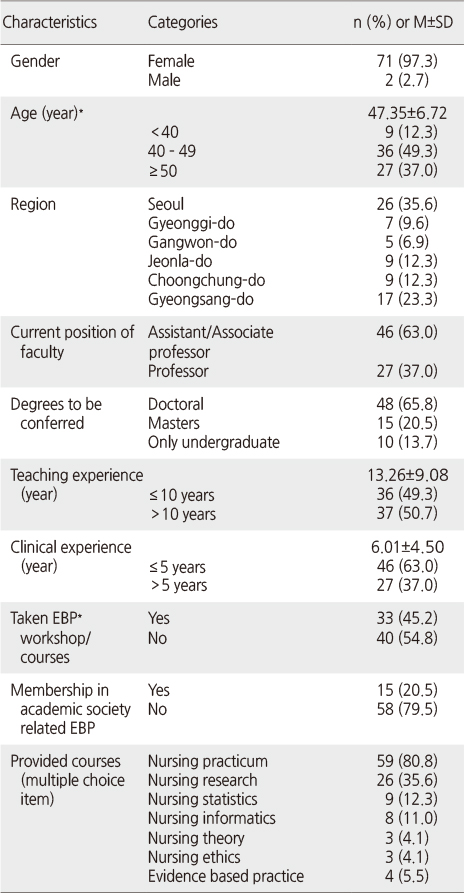
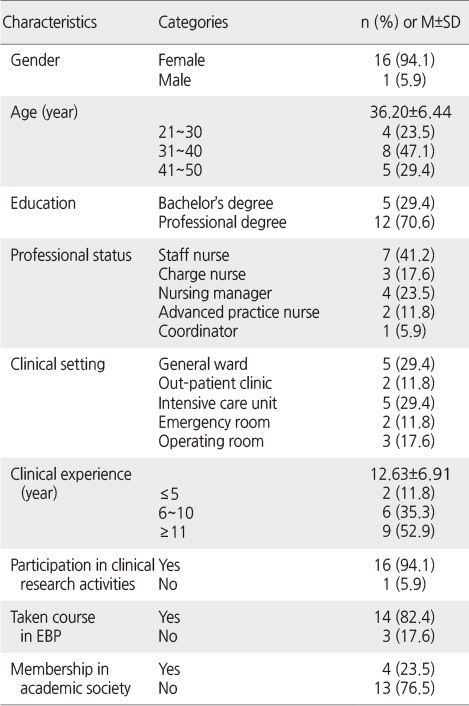
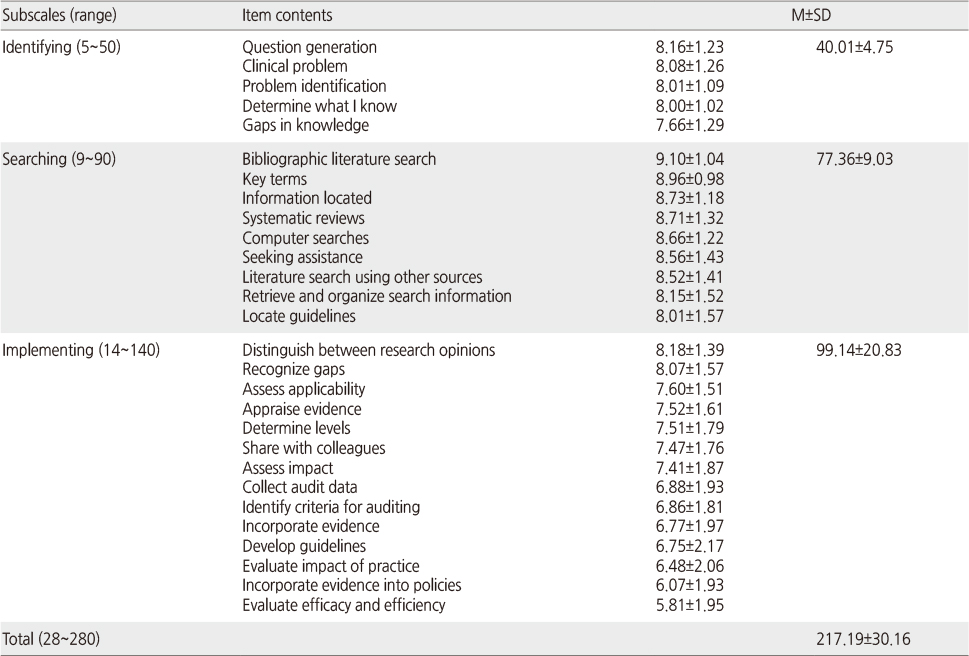
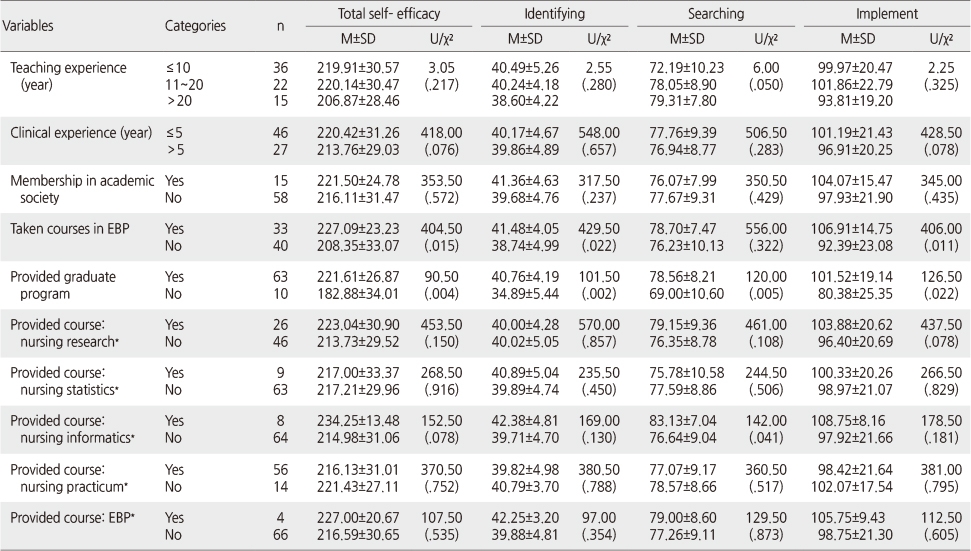
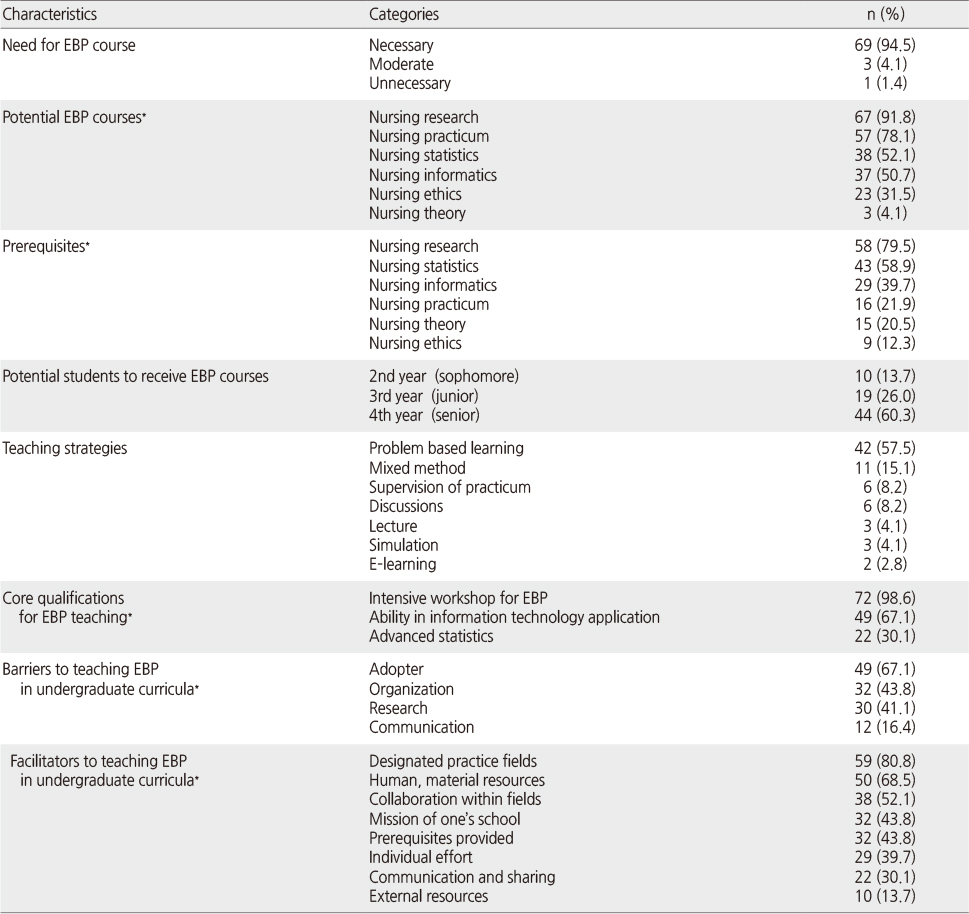
 Cite
Cite

